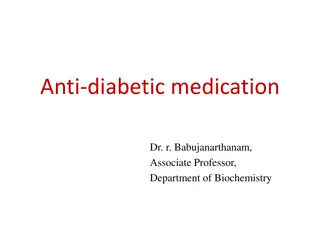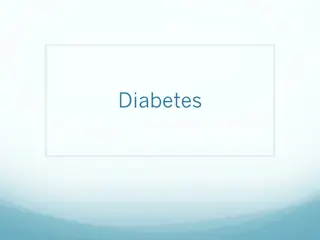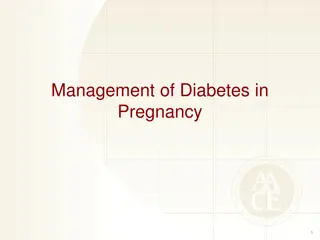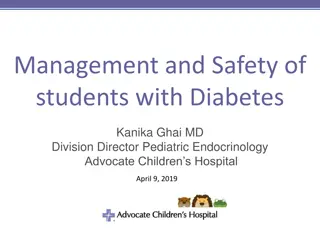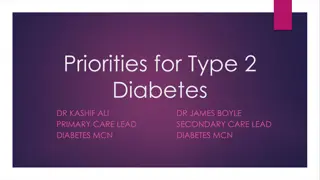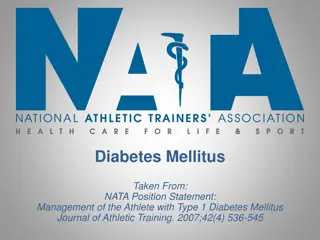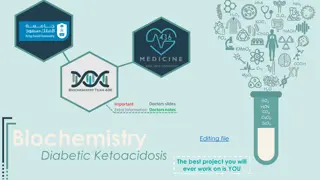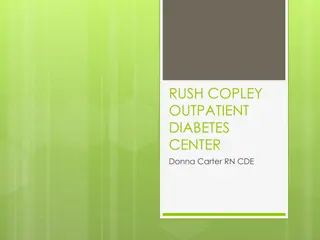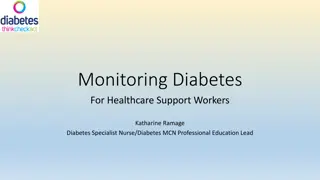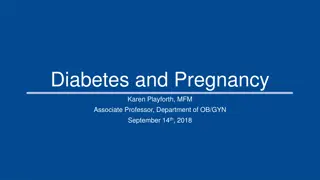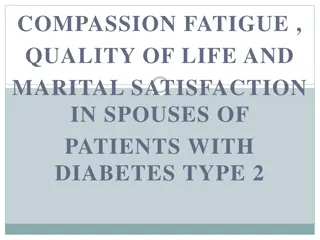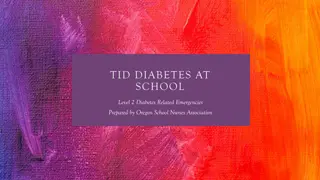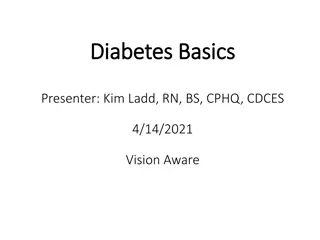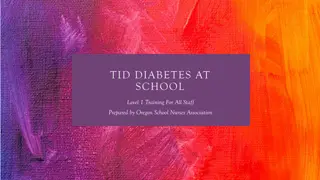Impact of Hypoglycemia in Diabetes Management
Hypoglycemia is a critical factor in the management of diabetes, leading to recurrent morbidity and compromising physiological and behavioral defenses. Understanding its etiology, frequency, and impact is crucial for prevention and treatment strategies. Recurrent hypoglycemia can have severe consequences, including irreversible brain damage and even death. Learn more about how different medications and insulin types contribute to hypoglycemic events and the importance of glycemic awareness in diabetes care.
Download Presentation

Please find below an Image/Link to download the presentation.
The content on the website is provided AS IS for your information and personal use only. It may not be sold, licensed, or shared on other websites without obtaining consent from the author.If you encounter any issues during the download, it is possible that the publisher has removed the file from their server.
You are allowed to download the files provided on this website for personal or commercial use, subject to the condition that they are used lawfully. All files are the property of their respective owners.
The content on the website is provided AS IS for your information and personal use only. It may not be sold, licensed, or shared on other websites without obtaining consent from the author.
E N D
Presentation Transcript
OBJECTIVES 1. OVERVIEW 2. ETIOLOGY 3. FREQUENCY 4. IMPACT OF HYPOGLYCEMIA IN DM 5. DEFINITION & CLASSIFICATION 6. PATHOPHYSIOLOGY 7. HAAF 8. RISK FACTORS FOR HYPOGLYCEMIA IN DM 9. PREVENTION OF HYPOGLYCEMIA IN DM 10. TREATMENT
OBJECTIVE 1: OVERVIEW Limiting factor in glycemic management of DM Recurrent morbidity in T1 & T2 Mortality Compromises physiologic & behavioral defenses against hypoglycemia Vicious cycle of Recurent hypoglycemia
Pathophysiology Metabolic state 50 160 mg/ dl G.H Insulin Cortisol Cathecholamines Glucagon Liver Fat cells
Glucose is unique fuel for brain neurons Hypoglycemia Irreversible brain damage
OBJECTIVE 2: ETIOLOGY More frequent with: Basal Insulin (GLARGINE & DETEMIR LESS NOCTURNAL HYPOGLYCEMIA THAN NPH) Prandial insulin (Rapid acting less hypoglycemia) Sulfonylurea (GIBENCLAMIDE >> GLIMEEPIRIDE) Glinides Less frequent with (cause hypoglycemia with insulin or SUR or Glinides): Biguanides (metformin) TZDs AGIs GLP1RAs DPP4Is
OBJECTIVE 3: FREQUENCY More frequent in T1 than T2 More frequent in advanced T2 Incidence is similar when matched for duration of insulin therapy T2 is more prevalent so more episodes of hypoglycemia is in T2 Not benign: impair defense against subsequent hypoglycemia 2 episodes of symptomatic hypoglycemia per week 1 episode of severe hypoglycemia per year: seizure or coma
OBJECTIVE 4: IMPACT OF HYPOGLYCEMIA IN DM Recurrent physical & psychological morbidity Impair glycemic defenses against subsequent hypoglycemia Functional brain failure reversible with glucose Rarely sudden death due to cardiac arrhythmia If prolonged: permanent brain dysfunction or death
OBJECTIVE 4: IMPACT OF HYPOGLYCEMIA IN DM Driving is dangerous: seizure or LOC Recurrent hypoglycemia does not cause chronic cognitive impairment 7-10% of deaths in T1 caused by hypoglycemia Death: 10% of SUR-induced hypoglycemia More deaths in T2 IN ACCORD study ? QTc prolongation & reduced baroreflex due to autonomic neuropathy cause sudden death
OBJECTIVE 5: DEFINITION & CLASSIFICATION All episodes of abnormally low plasma glucose that expose the individual to the potential harm Different from: causing symptoms or signs What is the threshold: Shift to lower plasma glucose in recurrent hypoglycemia Shift to higher plasma glucose in poorly controlled DM Glucose Alert Level: < = 70 mg/dl Repeating measurement Avoiding exercise until nl Avoiding driving until nl
OBJECTIVE 6: PATHOPHYSIOLOGY Insulin excess Defective glucose counterregulation & hypoglycemia unawareness Hypoglycemia unawareness: reduced release of NEN & ACH
Clinical manifestation 1. Neuroadrenergic: ( B.S < 55 - 60 ) Sweating Hunger Tremor Tingling Palpitation Anxiety Hypertension
2. Neuroglycopenia: ( B.S < 45 - 50 ) Nonspecific: Headach - restlessness - aggressiveness - bizarre behavior - weakness Focal sign: Monoplegia - babinski - paresthesia - diplopia - trismus - vision loss Global sign: Stupor - convulsion - flaccidity - hypothermia - decerebrate rigidity - coma
OBJECTIVE 7: HAAF HAAF: hypoglycemia associated autonomic failure: recent antecedent hypoglycemia, prior exercise, or sleep, can cause both defective counterregulation & hypoglycemia unawareness during subsequent hypoglycemia Attenuation of EN response Attenuation of sympathadrenal response and the resulting neurogenic response Vicious cycle of recurrent hypoglycemia
OBJECTIVE 8: RISK FACTORS FOR HYPOGLYCEMIA IN DM
OBJECTIVE 9: PREVENTION OF HYPOGLYCEMIA IN DM
OBJECTIVE 10: TREATMENT Glucose 15-20 gr is preferred for conscious patient with BG < 70 Any form of carbohydrate that contains glucose Added fat may retard and then prolong acute glycemic response If SMBG 15 min after glucose is low, repeat glucose If SMBG is normal, consume a meal or snack to prevent hypoglycemia
Treatment ( emergency ) 1. Conscious patient: Ingestion of 5-20 gr. Soft drink or sugar 2. Unconscious patient: a) Bolus : I.V 0.5 - 1 g/kg of hypertonic glucose b) maintenance : 5 - 10 g/h of glucose infusion. c) Glucagon : 0.5 - 1 mg I.v - I.m - S.c ( repeat ) 3. Post hypoglycemic coma: Hydrocortison 100 mg /t.I.d 20% Mannitol 200 cc/20 min
hypoglycemic patient cause by regular insulin excess-nutritional deficit or alcohol can be stabilized and discharged. hypoglycemia caused by intermediate or long acting insulin, First generation or second generation sulfonylurea at risk for prolong hypoglycemia
OBJECTIVE 10: TREATMENT Unable or unwilling (because of neuroglycopenia) to take carbohydrate orally, parenteral therapy is necessary Glucagon 1 mg SQ or IM May cause Nausea or vomiting Smaller doses (150 ug) repeated if necessary, effective without side effects Stimulate glycogenolysis: ineffective in binge of alcohol ingestion Causes hypoglycemia in nondiabetics because of insulin secretion
Lab data: CBC = nl Na = 146 K= 6 BUN = 120 Cr = 3
Poor intake Prerenal azotemia Metformine
Long duration of DM. Hypoglycemia unawareness blocker usage
Admission for at least 72 hours Serum : DW5% 100 cc / h saline for hydration






